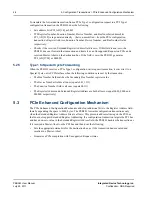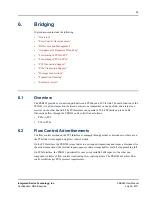
5. Configuration Transactions > Configuration Retry Mechanisms
47
PEB383 User Manual
July 25, 2011
Integrated Device Technology, Inc.
Confidential - NDA Required
5.4
Configuration Retry Mechanisms
A PCIe-to-PCI bridge is required to return a completion for all configuration requests that cross the
bridge from PCIe to PCI prior to expiration of the Completion Timeout timer in the Root Complex.
This requires that bridges take ownership of all configuration requests forwarded across the bridge. If
the configuration request to PCI completes successfully prior to the bridge’s timer expiration, the
bridge returns a completion with Normal Status on PCIe for that request. If the configuration request to
PCI encounters an error condition prior to the bridge’s timer expiration, the bridge returns an
appropriate error completion on PCIe. If the configuration request to PCI does not complete either
successfully or with an error, prior to timer expiration, the bridge is required to return a completion
with Configuration Retry Status (CRS) on PCIe for that request.
After the PEB383 returns a completion with CRS on PCIe, it continues to keep the configuration
transaction active on the PCI bus. For PCI, the PEB383 keeps retrying the transaction until it completes
on the PCI bus. When the configuration transaction completes on the PCI bus after the return of a
completion with CRS on PCIe, the PEB383 discards the completion information. Bridges that use this
option are also required to implement Bridge Configuration Retry Enable in the
. If this bit is cleared, the bridge does not return a completion with CRS on behalf
of configuration requests forwarded across the bridge. The lack of a completion results in eventual
Completion Timeout at the Root Complex.






























